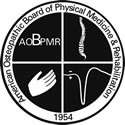American Osteopathic Board of Physical Medicine and Rehabilitation
The American Osteopathic Board of Physical Medicine and Rehabilitation (AOBPMR) is an organization that provides board certification to qualified Doctors of Osteopathic Medicine (D.O.) who specialize in the treatment of patients with physical impairments or disabilities (physiatrists). The board is one of 18 medical specialty certifying boards of the American Osteopathic Association Bureau of Osteopathic Specialists approved by the American Osteopathic Association (AOA),[3][4] and was established in 1954. The AOBPMR is one of two certifying boards for physiatrists in the United States. The other certifying authority is the American Board of Physical Medicine and Rehabilitation, a member board of the American Board of Medical Specialties. As of 2011, 220 osteopathic physiatrists held active certification with the AOBPMR.[5]
 | |
| Abbreviation | AOBPMR |
|---|---|
| Formation | 1954[1] |
| Type | Professional |
| Headquarters | Chicago, IL[1] |
| Coordinates | 41.8942°N 87.61902°W |
Chair | John L. Hart, DO[1] |
Vice-Chair | Jim R. Sylvain, DO |
Secretary-Treasurer | J. Michael Wieting, DO, MEd. |
| Website | aobpmr.org |
Formerly called | American Osteopathic Board of Rehabilitation Medicine[2] |
Board certification
To become board certified in physical medicine and rehabilitation, candidates must have completed an AOA-approved residency in physical medicine and rehabilitation and either one year of practice as a licensed physiatrist or one year of a physical medicine and rehabilitation fellowship following the completion of residency.[6] Additionally, candidates must have successfully completed the required oral and written examinations. Since 2004, board certified osteopathic physiatrists must renew their certification every ten years to avoid expiration of their board certified status.[7][8]
Diplomates of the AOBPMR may also receive Certification of Added Qualifications (CAQ) in Hospice and Palliative Medicine[9] and sports medicine after receiving additional training.[8][10][11]
See also
- American Osteopathic Association Bureau of Osteopathic Specialists
- Physical medicine and rehabilitation
- Physical Medicine and Rehabilitation Residency Programs in the United States
References
- "About the AOBPMR". American Osteopathic Board of Physical Medicine and Rehabilitation. 2010. Archived from the original on 24 February 2013. Retrieved 18 September 2012.
- Ayres, RE; Scheinthal, S; Gross, C; Bell, EC (March 2009). "Osteopathic specialty board certification". The Journal of the American Osteopathic Association. 109 (3): 181–90. PMID 19336771. Archived from the original on 2012-12-21. Retrieved 18 September 2012.
- "AOA Specialty Certifying Boards". American Osteopathic Association. Archived from the original on 1 June 2012. Retrieved 18 September 2012.
- "American Osteopathic Board of Physical Medicine and Rehabilitation". Health Workforce Information Center. 2011. Archived from the original on 14 April 2013. Retrieved 18 September 2012.
- Ayres, Ronald E; Scheinthal, S; Gross, C; Bell, E (April 2012). "Changes to Osteopathic Specialty Board Certification". Journal of the American Osteopathic Association. 112 (4): 226–231. Archived from the original on 4 March 2016. Retrieved 18 September 2012.
- "Eligibility Guidelines for AOBPMR Board Certification in Physical Medicine and Rehabilitation" (PDF). American Osteopathic Board of Physical Medicine and Rehabilitation. Archived from the original (PDF) on 1 October 2008. Retrieved 18 September 2012.
- "Applicant Handbook 2012" (PDF). American Osteopathic Board of Physical Medicine and Rehabilitation. 2012. Archived from the original (PDF) on 29 October 2013. Retrieved 18 September 2012.
- "Medical Boards: Osteopathic". Castle Connolly Medical, Ltd. Retrieved 18 September 2012.
- "Osteopathic Certification". American Academy of Hospice and Palliative Medicine. Retrieved 20 September 2012.
- "Specialties & Subspecialties". American Osteopathic Association. Archived from the original on 2015-08-13. Retrieved 18 September 2012.
- "Certification". American Osteopathic Board of Physical Medicine and Rehabilitation. 2010. Archived from the original on 24 February 2013. Retrieved 18 September 2012.